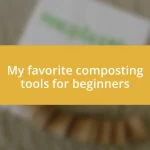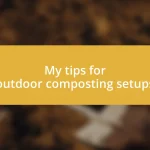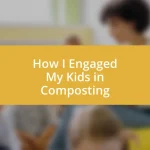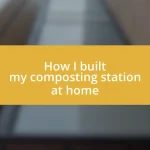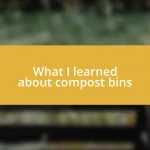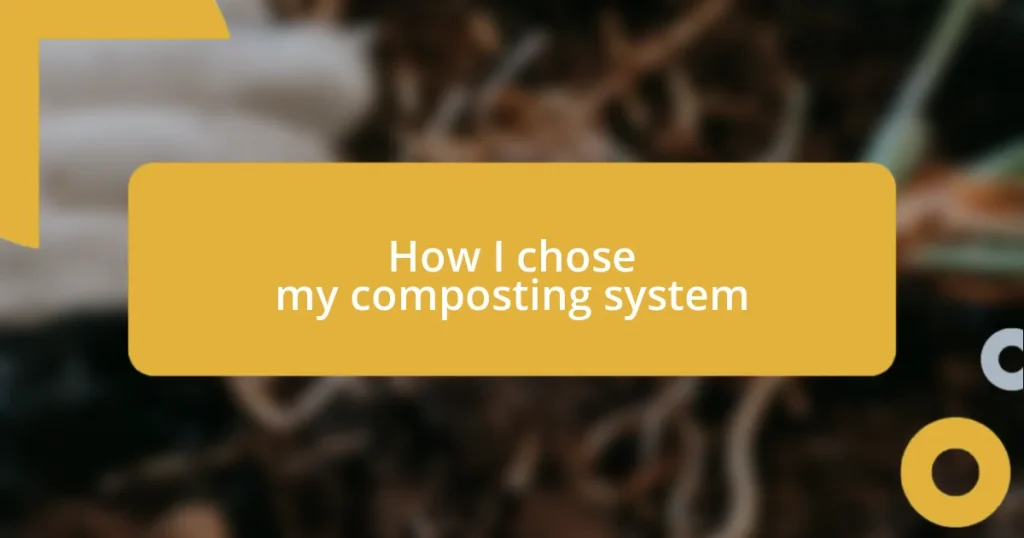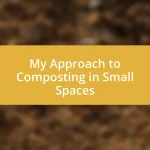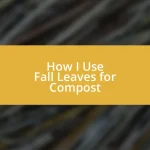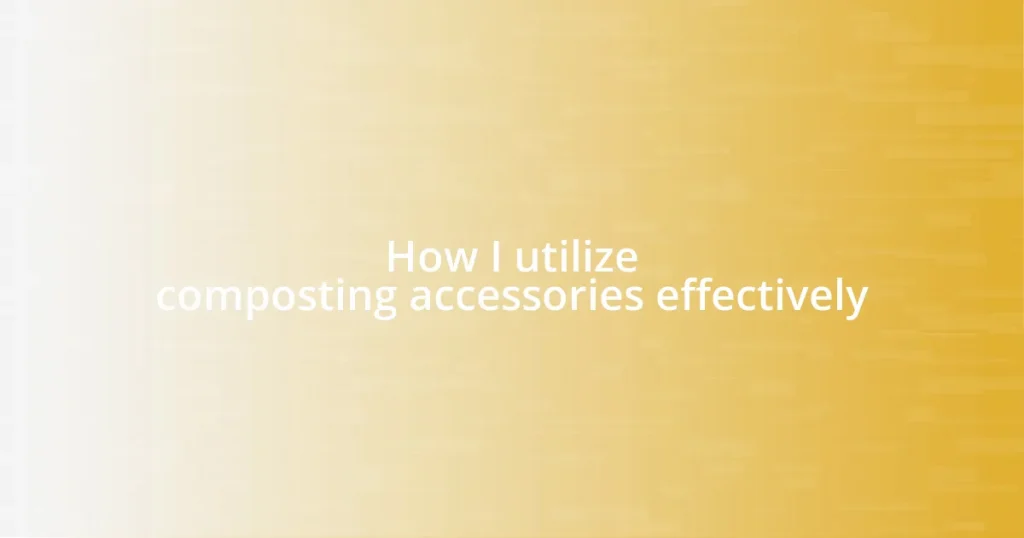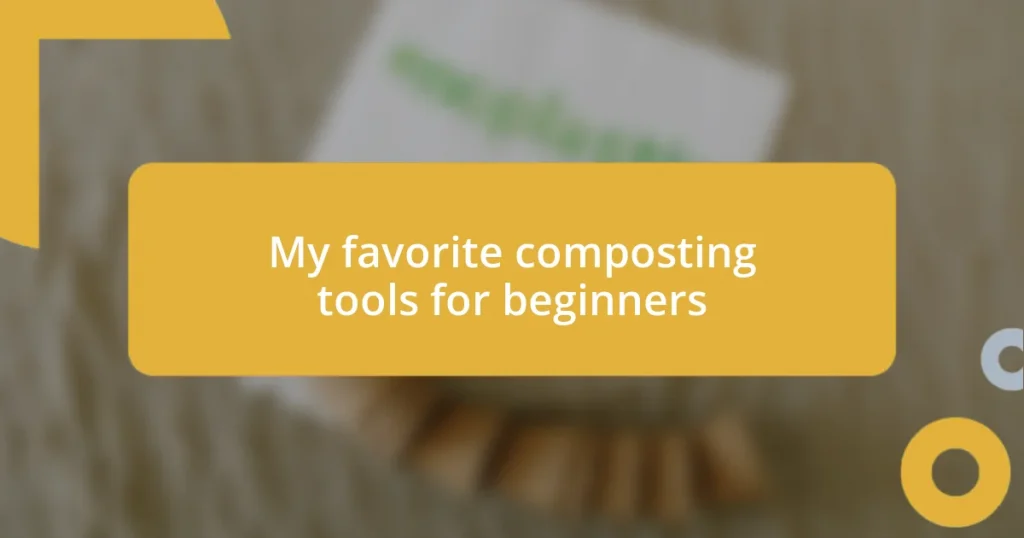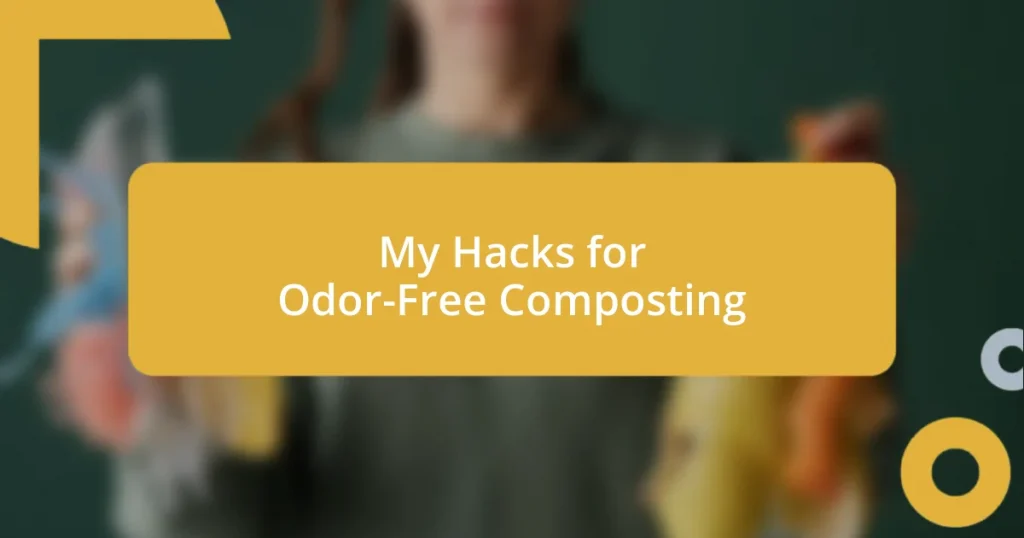Key takeaways:
- Understanding the various composting systems and their unique benefits is crucial for choosing the right method that fits one’s lifestyle and space.
- Evaluating specific composting needs, such as space availability, type of waste, and time commitment, helps narrow down options for an effective composting solution.
- Maintaining a composting system requires attention to the balance of materials, moisture levels, and regular aeration to ensure successful decomposition.

Understanding composting systems
Composting systems come in various forms, each designed to cater to different needs. I remember the first time I decided to start composting; I was overwhelmed by the choices available. Do you go for a classic bin, a worm composter, or maybe even a tumbling system? Each option has unique benefits and challenges that can greatly influence your composting journey.
For instance, my introduction to a worm composter opened up a whole new world for me. Watching the worms work their magic was fascinating, almost like a little ecosystem right in my kitchen. I often wondered, how can such small creatures transform waste into nutrient-rich soil? It was a revelation that deepened my connection to the environment and gave me a sense of purpose.
Furthermore, understanding the science behind composting helped me appreciate its nuances. The balance of greens (nitrogen-rich materials) and browns (carbon-rich materials) is crucial. Have you ever thought about what happens when that balance is off? I had my fair share of smelly compost bins, which taught me that a little knowledge goes a long way in creating a thriving compost system.

Evaluating composting needs
When I first considered composting, I realized I needed to evaluate my specific composting needs. It wasn’t just about choosing a system; it was about understanding what would work best for my lifestyle. For example, I live in a small apartment, so space became a crucial factor in my decision-making process.
Here are a few considerations that guided me in evaluating my composting needs:
– Space Availability: How much room can I dedicate to composting?
– Type of Waste: What kind of kitchen scraps and yard waste do I generate most?
– Time Commitment: How often can I dedicate time to manage the compost?
– Composting Goals: Am I looking for soil enrichment for gardening, or just reducing waste?
– Local Regulations: Are there any rules about composting in my area, like restrictions on certain materials?
By answering these questions, I was able to narrow down my options and choose a system that felt right for me. It felt like piecing together a puzzle that not only fit my needs but also connected me to a broader sustainability effort.

Researching different composting methods
Researching different composting methods can be an exciting journey, filled with discoveries about how to make the most of organic waste. I found digging into various methods illuminated aspects I hadn’t considered before. For instance, while learning about bokashi composting, I realized I could compost not just fruit scraps, but also meat and dairy, which are typically off-limits in traditional systems. This versatility opened new possibilities for my composting routine.
In addition to exploring different types, I also compared the process times and inputs required. I distinctly remember one late-night reading session, when I stumbled upon aerated static pile composting, which fascinated me due to its efficiency and minimal hands-on work. The idea that I could create compost without constantly turning the pile appealed to my busy lifestyle. By listing out various methods, I felt empowered to make an informed choice that would fit seamlessly into my daily routine.
Here’s a simple comparison to illustrate some of the methods I researched:
| Composting Method | Key Features |
|---|---|
| Worm Composting | Great for small spaces and produces rich castings quickly. |
| Hot Composting | Requires regular turning but decomposes organic material rapidly. |
| Bokashi | Ferments waste and allows for meat and dairy products. |
| Tumbling Composter | Simple to use and speeds up decomposition with minimal effort. |
| Aerated Static Pile | Low maintenance and good air circulation leads to efficient composting. |
I believe that understanding these differences not only equipped me with the knowledge I needed but also made me excited about the ongoing process of composting. What methods resonate with you, and how do they fit your approach to waste reduction?

Comparing composting system features
When comparing composting systems, I found it vital to consider factors like durability and efficiency. For instance, the construction material often dictates how long a composter will last. I once opted for a plastic tumbler, enthralled by its sleek design and promise of speedy compost. However, as time marched on, I realized its fragility in extreme weather didn’t suit my climate.
I also found features like the ease of use to be a game-changer. For me, a system that emphasized user-friendliness made all the difference. One chilly afternoon, I witnessed a neighbor effortlessly turning their tumbler and thought: why not have that convenience? I craved a similar experience that didn’t involve back-breaking effort, so I leaned towards systems that promised straightforward mechanics.
In addition to these practical elements, I couldn’t overlook capacity. The size and volume a composter could handle mattered to me because my food scraps often accumulated quickly. One time, I underestimated my kitchen waste output; it was a frantic endeavor to compress and manage it all before it started to smell. This experience reinforced my understanding that a system aligning with my waste generation would truly fulfilling my composting goals.

Selecting the best composting option
Selecting the right composting option can feel overwhelming, especially with so many methods available. I remember the joy of discovering how worm composting could transform my small apartment into a thriving ecosystem. The idea of nurturing red wrigglers made me feel connected to nature, even in an urban jungle. It sparked a thrill in me—could a handful of worms truly make a difference in my waste footprint?
As I delved deeper, my preference for hands-off approaches started to shine through. Hot composting initially intrigued me with its rapid results, but the thought of regularly turning the pile felt daunting. I wanted a system that complemented my busy life, so my search led me to tumbling composters. I vividly recall standing in a garden center, weighing my options against the promise of less effort and faster composting. I couldn’t help but think: wouldn’t it be wonderful to enjoy rich compost without the back-and-forth work involved?
Capacity and space were also significant factors in my decision-making process. I can’t forget the panic when I had to shove overflowing kitchen scraps into my small bin during a particularly productive cooking spree. That taught me a valuable lesson—finding a composter that could handle my waste output while fitting in my limited space was crucial. Reflecting on that, I realized the best composting option needed to align with my lifestyle, not the other way around. What has your experience been with choosing systems that harmoniously fit your routine?

Setting up your composting system
Setting up my composting system was an exciting yet slightly daunting project. I recall the day I finally decided on a location in my backyard. It was a sunny Saturday morning, and I could almost visualize the thriving ecosystem that would soon come alive. Choosing a spot with good drainage and partial sunlight made all the difference, ensuring that my compost would break down efficiently. Have you given thought to where your composting setup will go?
Next, I focused on assembling the necessary materials. After a bit of research, I landed on a simple yet effective design: a three-bin system that could handle my growing kitchen scraps and yard waste. I remember the satisfaction of sawing wood and securing the bins, transforming my vision into reality. The tactile experience of crafting my compost system was exhilarating; it felt like I was building a sustainable life right in my own backyard.
Finally, I laid the groundwork with layers of carbon-rich browns—like dried leaves and cardboard—and nitrogen-rich greens, such as vegetable scraps. I distinctly remember wondering whether I had the proportions right. I even performed a little “sniff test,” curious if the compost would smell earthy or funky. That moment reinforced my commitment to ensuring a balanced approach. It was a simple yet profound insight: the foundations of a successful compost system lie in attention to detail and a little experimentation. Have you thought about your initial materials? Your choices can set the tone for your composting journey!

Maintaining your composting system
Maintaining my composting system has been a journey of discovery and constant adjustment. I learned early on that the balance between greens and browns was crucial. I remember one week when too many kitchen scraps turned the pile into a smelly mess—what a wake-up call! Since then, I’ve kept a visible chart in my kitchen, reminding me to add more carbon-rich materials when my compost starts to feel off-balance. Have you experienced that moment when your compost goes awry?
Monitoring moisture levels is another aspect I pay close attention to. There was a time when I had a particularly dry spell, and my compost began to stall. I can still recall sifting through the mix, feeling like a detective on the hunt for clues. A sprinkle of water worked wonders, bringing it back to life. I’ve learned that keeping it damp, like a wrung-out sponge, promotes the right microbial activity. Do you check the moisture regularly, or have you found yourself surprised by dry compost?
Lastly, I’ve realized that regular turning or mixing keeps my composting system active and aerobic. At first, I was hesitant to dig in, but armed with a pitchfork, I felt empowered. Every time I turned the pile, it felt like I was waking up a hidden world of microorganisms. It became oddly satisfying to feel the heat build as I aerated the mix; that meant my compost was thriving. How often do you engage with your compost? It’s more than just maintenance; it’s an opportunity to connect with nature and witness the magic of decomposition firsthand.

